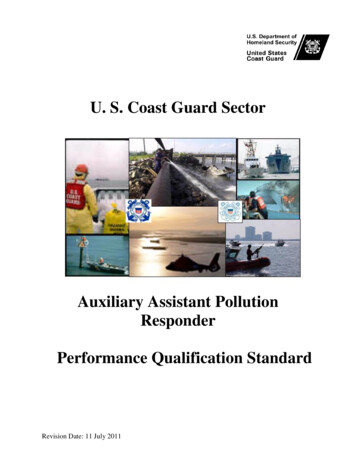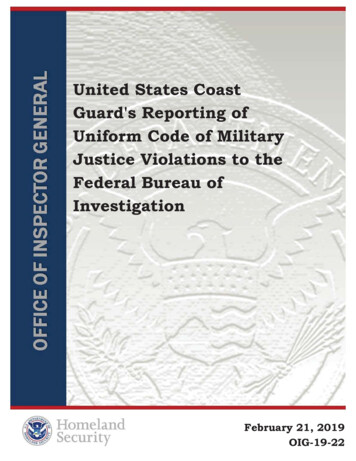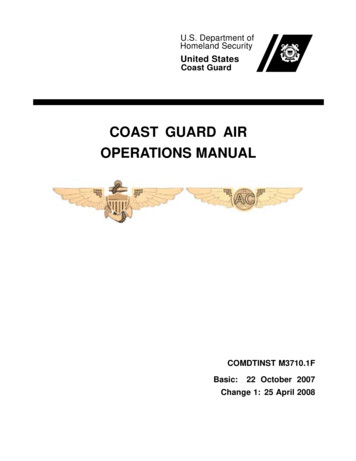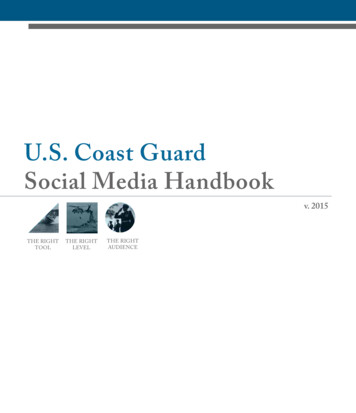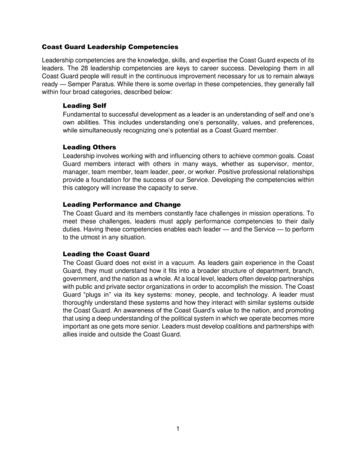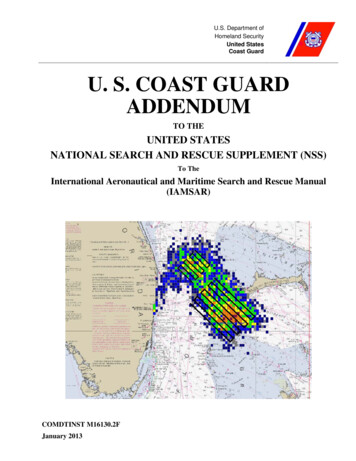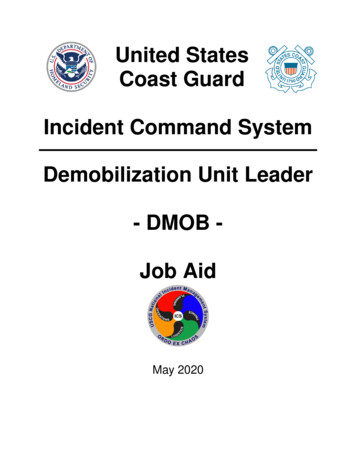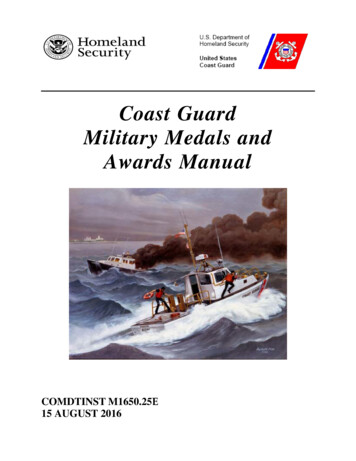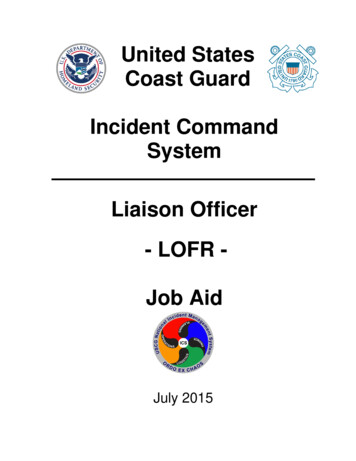
Transcription
United StatesCoast GuardIncident CommandSystemLiaison Officer- LOFR Job AidJuly 2015
USCG LOFR Job Aid2This is an example Liaison Staff organization whichcould be larger or smaller depending on incident needsInsert resource CD here
USCG LOFR Job Aid3Table of Contents1.0 Overview61.1 User . 61.2 When to Use . 61.3 Scope. 71.4 Major Accomplishments for the LOFR Position . 81.5 References . 121.6 Materials and ICS Forms . 13Checklists15Pre-Assignment Actions Checklist . 15Ready for Operational Tasking Checklists . 15Support the ICS Process Checklists . 18Operations Briefing . 19Manage Personnel Checklist . 20Demobilization Checklist . 212.0 Ready for Deployment222.1 Pre-Assignment Actions . 223.0 Ready for Operational Tasking243.1 Pre-Deployment Actions . 243.2 Check-In to the Incident - Initial Actions . 273.3 Situation Assessment . 303.4 Receive Initial Brief . 333.5 Activate Liaison Organization . 353.6 Organize and brief subordinates . 413.7 Initial Liaison Assessment and Actions . 414.0 Manage Personnel464.1 Lead Personnel . 464.2 Liaison Staff Meeting . 48
USCG LOFR Job Aid44.3 Debrief Personnel .494.4 Safety .505.0 Support the Planning Process515.1 Command and General Staff Meeting .515.2 Preparing for the Tactics Meeting .555.3 Tactics Meeting .565.4 Preparing for the Planning Meeting .575.5 Planning Meeting .585.6 Post-Planning Meeting Actions .595.7 Operations Briefing .605.8 Execute Plan and Assess Progress.616.0 Manage Stakeholders636.1 Implement Stakeholder Coordination Plan .636.2 Stakeholder Meetings .636.3 Documentation .647.0 Demobilization8.0 Appendices66678.1 Personal Deployment Kit .678.2 LOFR Deployment Kit.688.3 Functional Interactions .698.4 Example ICS 202 Incident Objectives .738.5 Example ICS 202A Command Direction.748.6 Example ICS 202B Critical InformationRequirements .758.7 Example ICS 213RR CG Resource RequestMessage .768.8 Example ICS 214 Unit Log .778.9 Example ICS 237-CG Incident MISHAP ReportingRecord .798.10 LOFR Contact Profile Sheet .80
USCG LOFR Job Aid58.11 Agency Representative (AREP) ContactWorksheet . 828.12 Decision Process to Determine an Agency’s Roleon an Incident . 858.13 Liaison Officer Stakeholder Meeting PreparationChecklist. 868.14 Example Stakeholder Coordination Plan . 888.15 Example Stakeholder Engagement Matrix . 958.16 Liaison Officer VIP Checklist . 978.17 Conducting an Open House . 1008.18 Liaison Effectiveness Checklist . 1028.19 Liaison Officer Activities in the ICS PlanningProcess . 104
USCG LOFR Job Aid61.0 Overview1.1 UserThe user of this job aid will be anyone assigned asLiaison Officer (LOFR) within the National IncidentManagement System (NIMS) Incident CommandSystem (ICS).The job of liaison during an emergency responseis a critical one. It can have a large impact on theefficiency of resource use during the responseoperations, and on the perception of stakeholdersregarding the success or appropriateness of theresponse activities. Both of these factors arecritical to overall response success.Personnel assigned to this position should have agood liaison/governmental affairs background andexperience working with people in otherorganizations. Since this is a key position in theresponse organization, assignment should bebased on experience level versus rank.1.2 When to UseThis document is intended as a reference Job Aidto assist the LOFR in understanding the complextasks and processes they may face when the ICSis used. It is not a policy document, nor intendedto act as or replace official policy, required trainingor direction from higher authority. It is rather
USCG LOFR Job Aid7guidance for response personnel requiringapplication of judgment.DISCLAIMER: This Job Aid is intended to provideguidance to Coast Guard personnel and is notintended to, nor does it impose legally-bindingrequirements on any party outside of the CoastGuardQuestions about this Job Aid should be directed tothe Coast Guard Office of ContingencyPreparedness and Exercise Policy (CG-CPE).1.3 ScopeThis Job Aid focuses on the role of the LiaisonOfficer in executing duties under the IncidentCommand System to ensure the effectivecoordination with participating organizations andstakeholders involved in the response. This JobAid is designed to be used in concert with the U.S.Coast Guard's Incident Management Handbook(IMH). This Job Aid assumes that the LiaisonOfficer has a thorough knowledge of the IncidentCommand System and the user has fundamentalskills in liaison and governmental affairs.Note: The term “stakeholder” as used in this jobaid is inclusive of all outside entities with whom the
USCG LOFR Job Aid8Liaison Officer may interact, such as assisting andcooperating agencies, coordination facilities,elected officials, public, special interest groups,land owners and affected parties. This is notmeant to alter any NIMS ICS doctrine.1.4 Major Accomplishments for the LOFRPositionThe LOFR is responsible for effectivelycoordinating with participating organizations(assisting and cooperating agencies) andstakeholders in support of the incident. Ready for Deploymento Prepare for Assignment in terms of Individualreadiness and position readiness Ready for Operational Taskingo Check-in Properly to incident
USCG LOFR Job Aid9o Obtain Situation Assessment and receiveInitial Briefo Lead transition from initial response phase(reactive mode) to an on-going operationsphase (proactive mode)o Activate Planning Section and ensureappropriate staffing of the planning sectionand its units Manage Peopleo Supervise and manage the Liaisonorganization and ensure the personnelassigned effectively support the needs of theresponse organizationo Provide appropriate information, delegation,authority, and accountability to the Liaisonstaff in order to enable them to be successfulin executing their functional responsibilitieso Manage the Liaison Staff Organization,including the assignment of Assistants andforming teams where necessary.o Effectively use Assistant Liaison Officers(ALOFR) to manage work activities in theIncident Command Post (ICP) and assignALOFRs to other locations where directlinkage to the ICP is necessary, such asEmergency Operations Centers (EOCs),Command Centers and or the Joint FieldOffice (JFO).
USCG LOFR Job Aid10 Manage Stakeholderso Develop and maintain a StakeholderCoordination or Outreach Plan or process.o Serve as primary incident point of contact forAgency Representatives.o Maintain a list of assisting and cooperatingagencies and Agency Representativesincluding name and contact information.Monitor check-in sheets daily to ensure that allAgency Representatives are identified.o Establish and coordinate with interagencycontacts.o Keep assisting and cooperating agencies andother stakeholders supporting the incidentaware of incident status.o Monitor incident operations to identify currentor potential inter-organizational problems.o Serve as key contributor to the positive publicperception of the response effort.o Serve as primary point of contact for allstakeholders who are not represented on theincident management team (IMT) and ensuretheir concerns, input, objectives, and issuesare effectively addressed by the responseeffort.o Review support and/or contingency plans forintegration of stakeholder input andinvolvement.
USCG LOFR Job Aid11o Develop, review and approve liaison relateddocuments.o Ensure all Liaison activities are documentedon ICS 214, Unit Log.o Complete all required forms anddocumentation prior to demobilization. Support the Planning Processo Coordinate response resource needs forincident activities with the OSC.o Effectively channel assisting agency resourcesand cooperating agency support into theoperational planning process in order to havepositive effects on the response effort.o Participate in the Command and General Staffand Planning meetings providing limitationsand capability of assisting agency resources.o Brief Command on liaison issues andconcerns.o Review the Incident Action Plan (IAP) toensure liaison oriented objectives, messages,issues and information are included asappropriate.The responsibilities of the LOFR and the PIO oftenbecome intertwined because each position dealswith entities outside of the response organization,i.e., public entities. In order to eliminate confusion
USCG LOFR Job Aid12and overlap, the LOFR and PIO should discussand decide on the delineation of certainresponsibilities. An example of such delineationwould be the following: LOFR is responsible to deal with any publicentity, namely assisting and cooperatingagencies, stakeholder groups, and governmentofficials who have a vested interest and will beexpected to provide input into the responseprocess and will expect situation reports fromthe Incident/Unified Command. LOFR is responsible for protocol functions, i.e.,the logistics of honors, etc. for visitingdignitaries. The LOFR will coordinate escortsfor visiting dignitaries to represent the IncidentCommander/Unified Command (IC/UC). PIO is responsible to deal with the media andgeneral public where the objective is mainly toprovide information to them.1.5 ReferencesBelow is a list of references that may be requiredwhile using this job aid: Incident Management Handbook (IMH)COMDTPUB P3120.17 is the key reference forexecuting Incident Command System processes.
USCG LOFR Job Aid13The IMH is available on the Coast Guard ICSweb pages at http://homeport.uscg.mil/ics/. USCG Liaison Officer (LOFR) PerformanceQualification Standard (PQS)1.6 Materials and ICS FormsEnsure you have appropriate Liaison materialsduring an incident. See 8.2 LOFR Deployment Kitfor a list of items to bring. ICS Forms can befound on the Coast Guard ICS web pages athttp://homeport.uscg.mil/ics/. Generally, theLOFR will either work with or have responsibilityfor information on the following forms: IAP Cover Sheet ICS 201 Incident Briefing ICS 202 Incident Objectives ICS 202A Command Direction ICS 202B Critical Information Requirements ICS 203 Organization Assignment List ICS 204 Assignment List ICS 204A Assignment List Attachment ICS 205 Communications Plan ICS 205A Communications List ICS 206 Medical Plan ICS 207 Incident Organization Chart ICS 208 Site Safety and Health Plan ICS 209 Incident Status Summary
USCG LOFR Job Aid 14ICS 210 Status Change CardICS 211 Check-In ListICS 213 General MessageICS 213RR-CG Resource Request MessageICS 214 Unit LogICS 214A Chronology of Events LogICS 215 Operational Planning WorksheetICS 215A Incident Safety Plan AnalysisICS 220 Air Operations SummaryICS 221 Demobilization Check-OutICS 219 Resource Status T-CardsICS 225 Incident Personnel PerformanceEvaluationICS 230 Daily Meeting ScheduleICS 232 Resources at RiskICS 233 Open Actions TrackerICS 234 Work Analysis MatrixICS 235 Facility Needs Assessment WorksheetICS 236 Tentative Release ListICS 237 Incident Mishap ReportICS 238 Demobilization Tracking Table
USCG LOFR Job Aid15ChecklistsPre-Assignment Actions Checklist Ensure personal readiness for assignment(See detail on page 22) Ensure LOFR certification is current(See detail on page 23) Assemble LOFR Deployment Kit(See detail on page 23 and 8.2 LOFR DeploymentKit)Ready for Operational Tasking ChecklistsPre-Deployment Actions Receive assignment(See detail on page 24) Verify reporting location, date and time(See detail on page 24) Finalize personal readiness for assignment(See detail on page 24 ) Receive travel orders and order number(See detail on page 25) Make travel arrangements(See detail on page 25) Verify/Update personal deployment kit(See detail on page 2524 and 8.1 PersonalDeployment Kit) Verify/Update LOFR deployment kit(See detail on page 25 and 8.2 LOFR DeploymentKit)
USCG LOFR Job Aid16Check-In to Incident - Initial Actions Check-in(see detail on page 27) Travel orders - Finance(see detail on page 28) Berthing assignment and Meal ScheduleLogistics (see detail on page 28)Review & sign Site Safety & Health Plan(see detail on page 29)Situation Assessment What kind of incident?(see detail on page 31) Who are key players?(see detail on page 31) When incident occurred?(see detail on page 31) Where is incident location/AOR?(see detail on page 31) Incident organization?(see detail on page 32) Resources on-scene?(see detail on page 32) Initial Safety Assessment?(see detail on page 33) Next meeting or briefing?(see detail on page 33)
USCG LOFR Job AidInitial Brief Your role(see detail on page 33) Size and complexity of incident(see detail on page 33) Initial Safety Assessment(see detail on page 33) IC/UC expectations(see detail on page 34) Limitations and constraints(see detail on page 34)Activate Liaison Organization Establish work location(see detail on page 38) Organize and brief subordinates(see detail on page 41) Acquire work materials(see detail on page 40) Order Staff(see detail on page 41) Liaison Staff Organization(see detail on page 36)17
USCG LOFR Job Aid18Support the ICS Process ChecklistsCommand and General Staff Meeting Incident Situation(see detail on page 51) IC/UC opening remarks(see detail on page 52) Receive IC/UC direction(see detail on page 52) Provide Liaison Status Brief(see detail on page 54) Provide feedback to IC/UC onfocus/direction (see detail on page 54)Discuss interagency issues(see detail on page 54) Discuss Liaison Issues/Needs(see detail on page 54)Preparing for the Planning Meeting Conduct Liaison staff meeting(see detail on page 48) Obtain briefings from Asst LOFRs.(see detail on page 57) Meet with other IMT personnel concerningLiaison issues (see detail on page 57)Prepare Liaison Status Briefing(see detail on page on page 54)
USCG LOFR Job Aid19Planning Meeting Validate Operational Plan for nextoperational period (see detail on page 58) Provide Liaison Status Brief(see detail on page 58) Provide support for the proposed IncidentAction Plan (see detail on page 59)Post-Planning Meeting Actions IAP information to PSC: ICS 203 Organization – review(see detail on page 60) ICS 205a Communications List – Review(see detail on pages 60) Review Additional Plans for LiaisonconcernsCritical Information reporting(see detail on page 34) Obtain briefings from Asst LOFRs.(see detail on page )Operations Briefing LOFR provides Liaison Status Briefing(see detail on page 60)
USCG LOFR Job AidExecute Plan and Assess Progress Obtain briefings from Asst LOFRs.(see detail on page 61) Assess Liaison related activities(see detail on page 61) Review ICS 233 for open actions.(see detail on page 61)Manage Personnel ChecklistPersonnel Evaluation Criteria Crew morale?HighMedLow Are assignments completed on time? Are injuries exceeding normal operatingenvironment?Is team effectively interacting?Number of unresolved issues passed toCommand?Any aggression or frustration by teammembers?Possible solutions to problems/issues?20
USCG LOFR Job Aid21Demobilization Checklist Provide input to Demob Plan(see detail on page 66) Brief Replacement, as necessary(see detail on page 66) Replenish supplies (see detail on page 67)Provide documentation to DocumentationUnit ICS 213RR(s)ICS 214(s)ICS 225(s) on staffStakeholder Coordination PlanDecision Memos and/or other documentationTurn in equipment, as appropriateComplete ICS 221
USCG LOFR Job Aid222.0 Ready for Deployment2.1 Pre-Assignment Actions2.1.1. Ensure personal readiness forassignment:If you deploy without being personally ready, it willaffect your ability to respond and cause a burdenon the incident management team. Sinceresponses and deployment lengths can vary fromincident to incident, you should plan for a 30-daydeployment. Personal readiness includes: Medical/dental readinesso For military this means you are in the “green”in CG Business Intelligence (CGBI).o For civilians and auxiliarists, ensure you haveno outstanding issues that would prevent youfrom being deployed. (e.g. have a plan toensure you have enough medications for theentire period of the deployment) Uniforms – You have enough uniforms and/orappropriate clothing for an expecteddeployment. Financial Readiness – You need to be financiallyready to deploy. This means ensuring yourfinancial situation is in order.o Government travel credit card (GTCC) – youshould check your GTCC limit. If you expect
USCG LOFR Job Aid23to be deployed more than 30 days, your limitshould be increased (example from 2,500 to 10,000).o Ensuring bills will be paid while deployed.o Ensure you have a TPAX account. Family Readinesso Ensure you have a Dependent Care/Pet Careplan for when deployed. Please checkwww.militaryonesource.com for assistance.2.1.2 Ensure LOFR training and certification iscurrentAs per COMDTINST(s) and PQS. ICS training (e.g. ICS-300, ICS-402 LOFRposition specific training). Incident specific training HAZWOPER (if needed)2.1.3. Assemble LOFR Deployment Kit Ensure all items found in 8.2 LOFR DeploymentKit are ready to go BEFORE you get the call todeploy
USCG LOFR Job Aid243.0 Ready for Operational Tasking3.1 Pre-Deployment Actions3.1.1. Receive assignment You may receive your assignment via message,phone call, supervisor, or on orders3.1.2. Verify reporting location You should verify reporting location, date andtime, order number, as well as IncidentCommand Post (ICP) contact numbers forassistance with check-in3.1.3. Finalize personal readiness forassignment Review the pre-assignment checklist to ensurereadiness for assignment which includespersonal, dependent, and financial readiness Notify your chain of command of anyoutstanding readiness issues. This may meandelaying deployment to resolve the issue. Review LOFR IMT Interactions (see 8.3Functional Interactions)
USCG LOFR Job Aid253.1.4. Receive Travel Orders and order number As per Federal Travel Regulations (FTR), awritten order issued by a competent authority isrequired for reimbursement of travel expenses;however the FTR states that an urgent orunusual situation may require that travel beginbefore a written order can be given. Pleaserefer to the FTR to ensure all conditions are metwhen traveling under oral orders. The travel order number (TONO) and ordernumber are different. The order number will beused at check-in to verify the position that youwill be filling. Order Number is generally in the followingexample format: O374 (O is for Overhead, andthe 3 digit number is assigned by Logistics)3.1.5. Make travel arrangements Obtain counseling on entitlements andresponsibilities from a travel authorizing officialand review the FTR as necessary Request cash advances as required. Make travel arrangements using approved CGtravel method.3.1.6. Verify/update Personal Deployment Kit
USCG LOFR Job Aid26A personal Deployment Kit (see 8.1 PersonalDeployment Kit) contains your personal itemsneeded for the deployment and includes itemslike: Medications Uniforms and/or appropriate clothing Special PPE or special weather clothingrequired Verify if any special PPE will be provided by theincident3.1.7. Verify/update LOFR Deployment kit See 8.2 LOFR Deployment Kit Ensure manuals, forms and guides are currentversions (electronic and paper). Ensure supplies are restocked from lastdeployment.3.1.8. Obtain information about incident andArea of ResponsibilityIf possible, obtain information about the incidentyou are responding to. This includes: ICS 201 or IAP Stakeholders (assisting and cooperatingagencies, organizations, etc.) Contingency Plans Stakeholder Plan (if completed)
USCG LOFR Job Aid273.2 Check-In to the Incident - Initial ActionsThe following tasks should be accomplished assoon as possible after arriving on-scene.3.2.1. Check-in:Upon arrival at the incident,check-in at the IncidentCommand Post, Base, orStaging Area on the ICS 211.If you are in the firstgroup of personnelassigned and there isno check-in functionset up, contact theRESOURCEUNITLEADER (RESL) orPLANNING SECTIONCHIEF (PSC) anddiscuss the need for acheck-in process. Ensure you have your OrderNumber available. Thisenables the Check-inRecorder (CHKN) tovalidate your assignment to the incident quickly.The Order Number is generally in the followingformat:o Example: O374 (O is for Overhead, and the 3digit number is assigned by Logistics).o In some cases the incident may be using the16 digit government Travel Order Number(TONO) assigned to you as the OrderNumber. The incident will want a phone number whereyou can be reached, your home base, how yougot to the incident, as well as any additionalqualifications you may have
USCG LOFR Job Aid28 Receive assignment, if available. Although youprobably know why you are at the incident,Check-in may have a different assignment (e.g.Public Information Officer, Assistant LiaisonOfficer, etc). Incident credentials: On some incidents,credentials (badges) are created for all assignedpersonnel. If the incident is issuing credentials,you should receive them when you check-in.3.2.2. Finance Check-inTravel Orders: Provide a copy of your orders orother travel documents to the FSC or AdminOfficer. Orders written on a home unit TONO mustbe amended to use the funding source for theincident. Take care of this soon so it doesn’t holdyou up when you are ready to leave!3.2.3. Logistics Check-in Berthing assignment: The incident is responsiblefor ensuring you have adequate berthing unlessyou are locally based. If the incident is small,Logistics may ask you to make your ownarrangements, or they may have alreadycontracted with a local hotel for incidentpersonnel. Even if you have made your own
USCG LOFR Job Aid29arrangements, Logistics should still be trackingwhere personnel are berthed. Meal schedule: The size, complexity andlocation of an incident will impact the availabilityof meals.o On most Coast Guard responses, meals arethe responsibility of the individual since theyare on per diem, BAS or Separate Rationso If meals are provided the incident FDULgenerally tracks who got a meal and theindividual is required to make the appropriatemodification to their travel claim. Thegovernment is prohibited from providing ameal at no cost while paying the responderper diem for food.3.2.4. Safety - Review and sign the Site Safety& Health PlanAs a member of the command cadre, it is criticalthat you understand all of the incident hazards andmitigation strategies. Although you may only beimpacted by a few of these hazards, knowledgecan be the difference between zero accidents andpreventable injuries. This may or may not becompleted at the time you check-in.
USCG LOFR Job Aid30 Each incident should have a Site Safety &Health Plan where the Safety Officer (SOFR)has elaborated on these hazards These hazards should be factored into thedevelopment of the Medical Plan, Transportationand Traffic Plans, and design of incidentfacilities. Review and sign the Site Safety & Health Planindicating your awareness and understanding3.3 Situation AssessmentThe purpose of this task is to acquire additionalbackground on the incident prior to starting yourassignment. As a member of the IMT leadership,you will share in the success or failure ofcommands objectives. Part of “starting right” is foreach LOFR to take responsibility for getting ahandle on the situation so they have a betterunderstanding of the big picture. Regardless ofwhen you arrive at an incident, there is usuallyvery little time for someone else to brief you.Review the current ICS 201 and/or IAP for anoverview of current operations. Other sources ofinformation: Contingency Plans (ACP, AMSP, etc),Local Emergency Management, Local Police &Fire, and Contractors. The following tasks shouldbe accomplished AFTER checking-in to the
USCG LOFR Job Aid31incident. You need to find out the Who, What,When, and Where related to the incident: What is the incident (SAR, oil/hazmat, LE,natural disaster, etc.)? This will give you an ideaof the Critical Information Reporting (CIR)requirements and the Liaison issues you will bedealing with. Who are key players (Federal, State, local,industry)? This may give you some insight intothe stakeholders, why Command is settingparticular objectives and what Liaison issues orconcerns they may have. When did the incident take place? An incidentchanges character over time including; survivalrates, weathering of oil, potential contaminants,vessel stability, etc. As the LOFR you need toknow if the incident is expanding, steady state,or contracting. Where did the incident take place? Do you knowthe Area of Responsibility (AOR)? If so, youhave an advantage in knowing relationships,geography, local plans, etc. If not, you mustspend some time getting to know the area. Also,what is the difference between the unit/agencyAOR and the incident AOR? Generally, thereshould be a difference.
USCG LOFR Job Aid32 What is the incident organization? You mustknow who is in your direct chain of command aswell as other key players such as the IncidentCommander(s), Operations Section Chief(OSC), Planning Section Chief (PSC), FinanceSection Chief (FSC), and Logistics Section Chief(LSC). What resources are on-scene and/or enroute?This is not about memorizing resources.However, the LOFR should have a ballpark ideaof what is currently being utilized to support theoperations on-scene and the broad categories ofresources that will be required. This isespecially important for coordinating withstakeholders in the development of CriticalInformation Requirement (CIRs) requirements.For example:o Resources: Vehicles (sedan, buses, trucks,fire, etc), Vessels (law enforcement, deckcargo barges, oil recovery, etc), Helicopters(overflight, passenger carrying, heavy lift, etc),Expertise (environmental, salvage, lawenforcement, fire, etc.)o Support: Personal Protective Equipment,Radios, Cell phones, Porta-Johns, Adminequipment (e.g. copy machines, printers, faxmachines, etc.), Fuel, food, lodging,transportation, Facilities (base, staging areas)
USCG LOFR Job Aid33 When is the next scheduled meeting (check theICS 230, which should be posted in variouslocations around the ICP but always on theSituation Status boards)?3.4 Receive Initial BriefThe initial briefing is the opportunity for the LOFRto receive additional details about their incidentassignment. Depending on the phase and/or sizeof the incident, you may or may not get a chanceto spend this time with the Incident Commanderand/or Deputy IC before you start working. If youare NOT able to attend this brief, your next andmost important opportunity is the Command andGeneral Staff meeting. Your roleo How big a role are you playing? Does theincident involve multiple jurisdictions orseveral agencies? How many agencies andstakeholders are expected to be involved?o Do you have the experience for the role youare playing? Size and complexity of incident:o Is the incident expanding or contracting?
USCG LOFR Job Aid34o Will the IC(s) give you the authority to orderthe resources you need to effectively manageliaison issues for the incident? Expectations of the IC: IC’s come with manydifferent levels of expertise and experience. In amulti-hazard, multi-jurisdictional incident it ispossible and even probable that the IC(s) doesnot have expertise in providing proactiveoutreach services to assisting and cooperatingagencies and other stakeholders.o Do you have expertise in coordination andcommunications efforts with a myriad ofassisting and cooperating agencies,stakeholders, and other interested parties forthis type of incident?o Does command want a briefing from you onthe process and procedures you typically use?o How often does command want to beupdated? What are their trigger points? Limitations and Constraints (e.g. are you theright LOFR for the job?). While this may seemintuitive, you should always ask yourself thisquestion. Even if you lack experience orexpertise, can you bring on a Deputy and/or Unitleaders with the appropriate background?o Special concerns (e.g. reporting criteria)o Resource request process (see 8.7 ExampleICS 213RR CG Resource Request Message).
USCG LOFR Job Aid35o Resource ordering pro
Coast Guard's Incident Management Handbook (IMH). This Job Aid assumes that the Liaison Officer has a thorough knowledge of the Incident Command System and the user has fundamental skills in liaison and governmental affairs. Note: The term "stakeholder" as used in this job aid is inclusive of all outside entities with whom the
